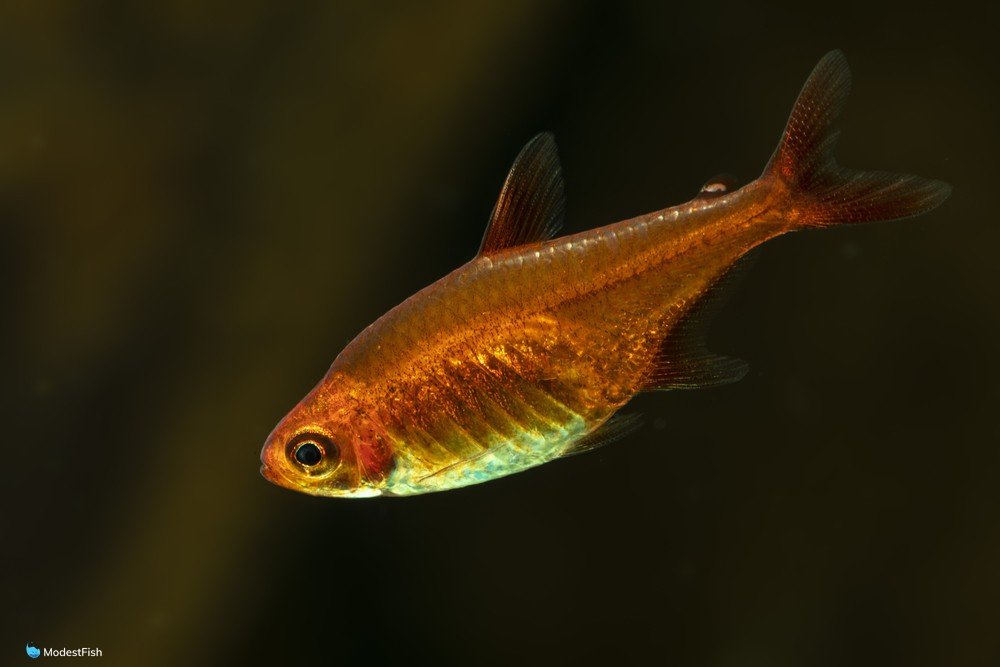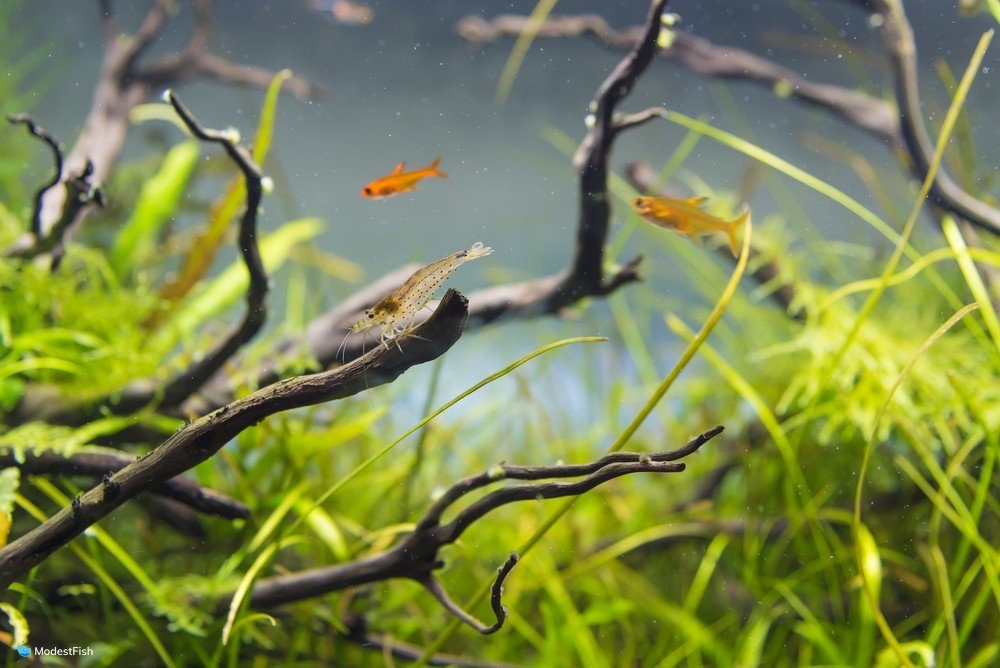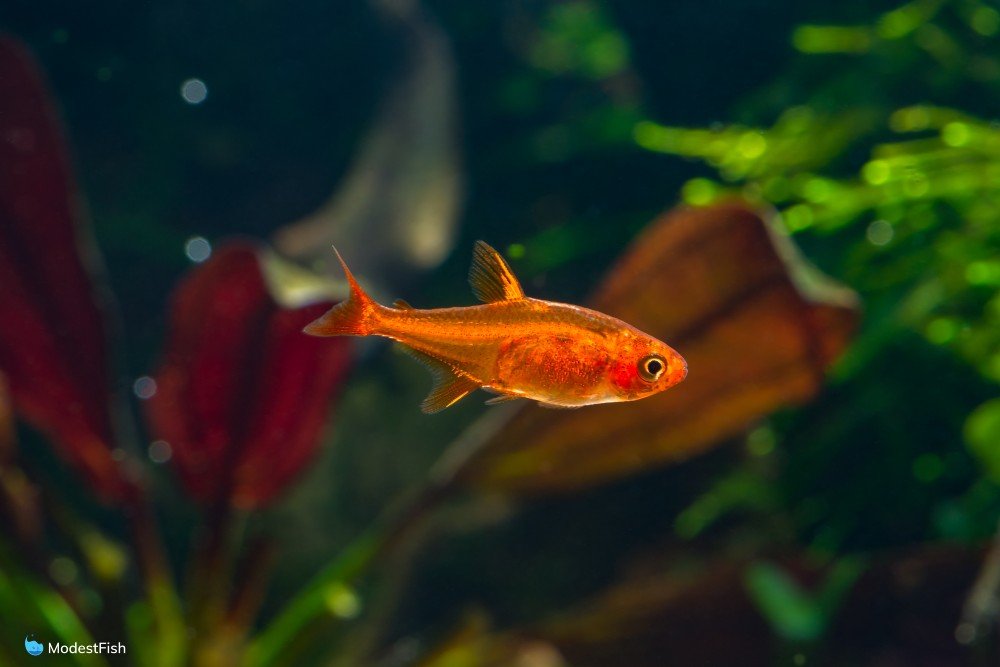Ember tetras are understandably popular among fishkeepers of all degrees of experience. These low-maintenance fish look breathtaking, and their behavior is active and social yet peaceful. In addition, their small size makes them great to pair up with other smaller tank mates.
As beautiful and mellow they are, Ember tetras don’t differ from other fish that need research prior to keeping them in order to understand their behavior, replicate their natural habitat, and meet their nutritional needs.
So, if you’re interested in being the best fishkeeper that you can be, read more to know everything there is to know about Ember tetra care.
Ember Tetra Origin & Appearance

Also known as Fire and Dwarf Red tetra, the Ember tetra (Hyphessobrycon amandae) is a small freshwater fish of the characin family that is native to the Araguaia River basin in Central Brazil, first spotted in Mato Grosso.
The natural habitat of Ember tetras is typically slow-flowing rivers with a substrate of fallen leaves, logs, branches, and water plants that make the water soft and slightly acidic. They’re also used to warm weather.
If you take one look at Ember tetras, you’ll understand their popularity among fellow fishkeepers. These fish look strikingly beautiful with bright colors that range from golden maple to fiery red. They’re also transparent near the pelvic fins.
The gradience of their coloration, especially on their fins and back, adds even more to their beauty. It’s definitely fun to watch these beautiful creatures.
Their fronts are fuller in size than their compressed backs, which enables them to move around swiftly. Keep in mind that mature female Ember tetras look fuller or rounder than their thinner male counterparts. In terms of size, all Ember tetras range from 0.6 to 0.8 inches, so they’re pretty small.
Care Stats Overview
- Common Name: Ember Tetra
- Tank size: 10 gallons
- Temperature: 73°F to 84°F
- pH: 5.0 to 7.0
- kH: 4 to 8
- Living zone: Araguaia River basin
- Size: 0.6 to 0.8 in
- Temperament: Peaceful
- Diet: Omnivore
Scientific Classifications
- Kingdom: Animalia
- Phylum: Chordata
- Class: Actinopterygii
- Order: Characiformes
- Family: Characidae
- Genus: Hyphessobrycon
- Species: H. amandae
Life Span
The average Ember tetra lives from 2 up to 4 years. Many factors come into play when it comes to how long this fish lives, such as the quality of water, diet, and, most importantly, the consistent and heavy existence of plants. Like any other fish, taking proper care of your Ember Tetra will help it live as long as possible.
Sexual Dimorphism
The sexual dimorphism isn’t hard to spot in Ember Tetras. Mature male Ember tetras have beautiful bright colors, and they’re quite noticeable when in spawning condition. On the other hand, female Ember tetras have a visible rounder form than their male counterparts once they mature.
Ember Tetra Care & Tank Set-up

Tank Size & How Many Can Be Kept Together
The ideal tank size for a small school of 5 to 8 Ember tetras is 10 gallons. The reason why we start by recommending a tank size for a school is that Ember tetras need to be in groups, ideally up to 10 or even more.
They’re considered shoaling fish, so they become under a lot of stress when they’re alone, even if you take good care of them. In addition, it’s actually easier and more efficient to take care of a group than one on its own.
That being said, if you have one Ember tetra, it only needs 2 to 3 gallons.
The Nitrogen Cycle
The nitrogen cycle is one of the most important aspects to consider in fishkeeping, not just Ember Tetra keeping. It ensures that the aquarium’s ecosystem is safe for fish to live.
The most common beginner mistake, usually called new tank syndrome, is not keeping the nitrogen cycle in mind while maintaining the water, which leads to disastrous outcomes with the fish.
An unhealthy buildup of ammonia and nitrite, which happens when there aren’t enough bacteria to break down fish waste in new aquariums, is invisible to the naked eye. So, always have a test kit to ensure the smoothness of the nitrogen cycle, which will ensure a healthy and long life for your fish.
Water Parameters
- Temperature: 73°F to 84°F
- pH: 5.0 to 7.0, ideally at 6.5
- kH: 4.0 to 8.0
- Hardness: 5 to 17 dGH
One of the reasons why fishkeepers love to have Ember tetras is that it’s not difficult to maintain the necessary water parameters for them, so beginners find them easy to take care of. In order to maintain these parameters, you need to buy a test kit and regularly test the water to ensure that the numbers are within the optimal range and haven’t changed drastically, affecting the fish.
In terms of temperature, they like things warm, ranging from 73°F to 84°F. Ember tetras also prefer slightly acidic water, ranging from 5.0 to 7.0, ideally at 6.5. Alkaline water leaves Ember tetras lethargic and weak, so it’s important to keep it under 7.
Plus, carbonate hardness, or kH, is vital when it comes to fish keeping. It’s a measurement of calcium carbonate in the water, and it matters because it keeps the pH stable. Ember tetras like it from 4.0 to 8.0, so they thrive in softer water.
Speaking of water softness, you should also consider the level of water hardness that your fish needs. Water hardness refers to the amount of all the minerals dissolved in the water. The ideal range of hardness for Ember tetras is 5 to 17 dGH.
The most important thing about water parameters like temperature, pH, kH, and hardness isn’t reaching a perfect number but keeping a stable number. Stability matters more to fish because it enables them to adapt, as they adapt to the conditions they were born and have lived in anyway.
On the other hand, swinging between these conditions will kill the fish, so focus all of your work towards stabilizing the water parameters. As long as your fish are happy and healthy within a certain range, maintain it.
Tank Set-Up
Your tank set-up varies according to fish species and their needs. Ember tetras are amazing in that their natural living conditions aren’t difficult to replicate. So, your fish can easily feel at home while being very low-maintenance.
Ember tetras originally live in low-current waters, so you’ll need to use a filter that doesn’t overwhelm them with strong water flow. The ideal option would be a sponge filter.
When it comes to lighting, Ember tetras don’t have crazy demands. However, if you want to make the tank feel exactly like its natural habitat, keep the tank dimly lit. Decoration-wise, all your Ember tetras will care about is heavy vegetation. In fact, that’s the only way these fish thrive, so make plants your priority and consider floating plants to diffuse the light.
You’re not required to use a certain type of substrate with these fish, but the dark substrate is the most aesthetically pleasing choice because it contrasts beautifully with the bright colors of the fish.
In addition, despite their small size, Ember tetras like to have an open space because they’re active and love to swim around. So, don’t overcrowd the tank with stones and wood and give your fish some room to breathe and school.
You’ll also need to consider the extra equipment you’ll need. When breeding Ember tetras, you’ll have to get a separate tank for the fry because otherwise, they’ll be eaten by mature Ember tetras and other fish. The fry tank requires a pump because stagnant water will lead to bacteria and fungus.
Ember Tetra Diet & Feeding

Like all fish species, Ember tetras need a balanced diet to give them the vitamins, proteins, and nutrients they need. They’re omnivores, so they have a wide range of foods to feed them. Try to balance things out by including high-quality fish flakes, freeze-dried, and frozen food.
Don’t forget to add in some small live foods from time to time, such as worms, daphnia, and brine shrimp, because they make the Ember tetra’s beautiful colors shine brighter.
That being said, don’t depend on live foods as a regular source of nutrition for your fish because there’s always a risk of contamination that may introduce parasites into the tank. So, treat live foods as an occasional snack with high nutritious value for your aquatic friends.
Also, be careful not to overfeed your Ember tetra. As a small fish species, overfeeding them is more common than not feeding them enough. So, if your fish looks lethargic despite maintaining stable water parameters, you could be overfeeding it. Try to limit them to three feedings per day. Only feed them what they can eat in only 2 minutes, or else the food will go to waste.
You may find your fish munching on plants from time to time, which is absolutely normal for an omnivore species. They’re not big enough to damage the plants anyway.
Behavior & Compatibility
As we’ve said before, Ember tetras are best kept in groups. So, get a group of 5 to 10 Ember tetras for the best results. Even better, go for up to 15. Otherwise, the fish will get stressed and sick.
In terms of behavior, Ember tetras are quite peaceful. However, they’re not shy and don’t hide away most of the time, despite their small size. In fact, you’ll enjoy watching how active they can get. That being said, giving them a few hiding places will make them feel safer if they get skittish.
As peaceful fish, they get along with many tankmates, which is the best part about having Ember tetras. Yet, it wouldn’t be wise to put such peaceful small fish in the same tank as predatory or large fish. So, avoid carnivorous or omnivorous species that may find them too delicious-looking if you want your Ember tetras to live.
Good tankmates are fish of a similar size that are non-aggressive. So, consider pygmy corydoras, discus, barbs, red cherry shrimp, neon tetras, hatchet fish, and, of course, Ember tetras. Bad tankmates include angelfish, pufferfish, and blood parrot cichlids.
Breeding Ember Tetras
Breeding Ember tetras is definitely much more straightforward than most fish species. If you have mature males and females, meaning over 4 to 6 months of age, you’re halfway there.
The slight tweaks that you’ll need to do are easy, even for beginner aquarists. Firstly, get the pH to a neutral 7.0. Secondly, raise the temperature to anywhere between 80°F and 82°F to replicate the warm weather of the spawning season in their natural habitat.
Also, remember that Ember tetras are free-spawning fish that don’t care for their fry. So, you’ll have to keep the fry alive by moving it to a separate small tank. Take the water from the original tank to get the fry accustomed. Also, dim the lights and tone down the filter to make the environment livable for the fragile fry.
Keeping Ember Tetras
Hopefully, you know enough about Ember tetra care by now to be a confident fishkeeper. Generally speaking, Ember tetras aren’t high-maintenance. Their needs are easy for beginners to meet, and they’re pretty hardy anyway.
Just remember to get a school of Ember tetras together, maintain the nitrogen cycle and water parameters at the levels that the fish are accustomed to, fill the tank with vegetation, feed them a balanced diet, pair them up with peaceful, non-aggressive species, and, of course, protect the fry when their parents breed.
Now, it’s time to enjoy the beautiful colors of your happy, healthy, and active Ember tetras. Happy fishkeeping!
